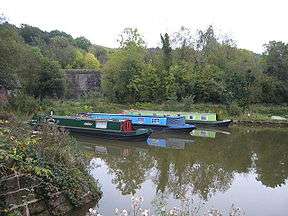Uttoxeter Canal
The Uttoxeter Canal ![]()
| Uttoxeter Canal | |
|---|---|
 The basin below lock 1, restored in 2005. | |
| Specifications | |
| Length | 13 miles (21 km) |
| Locks | 19 |
| Status | Possible restoration |
| History | |
| Original owner | Trent and Mersey Canal Company |
| Principal engineer | John Rennie |
| Date of act | 1797 |
| Date completed | 13 November 1811 |
| Date closed | 15 January 1849 (replaced by railway) |
| Date restored | July 2005 (1 lock and basin) |
| Geography | |
| Start point | Froghall |
| End point | Uttoxeter |
| Branch of | Caldon Canal |
Uttoxeter Canal | |||||||||||||||||||||||||||||||||||||||||||||||||||||||||||||||||||||||||||||||||||||||||||||||||||||||||||||||||||||||||||||||||||||||||||||||||||||||||||||||||||||||||||||||||||||||||||||||||||||||||||||||||||||||||||||||||||||||
|---|---|---|---|---|---|---|---|---|---|---|---|---|---|---|---|---|---|---|---|---|---|---|---|---|---|---|---|---|---|---|---|---|---|---|---|---|---|---|---|---|---|---|---|---|---|---|---|---|---|---|---|---|---|---|---|---|---|---|---|---|---|---|---|---|---|---|---|---|---|---|---|---|---|---|---|---|---|---|---|---|---|---|---|---|---|---|---|---|---|---|---|---|---|---|---|---|---|---|---|---|---|---|---|---|---|---|---|---|---|---|---|---|---|---|---|---|---|---|---|---|---|---|---|---|---|---|---|---|---|---|---|---|---|---|---|---|---|---|---|---|---|---|---|---|---|---|---|---|---|---|---|---|---|---|---|---|---|---|---|---|---|---|---|---|---|---|---|---|---|---|---|---|---|---|---|---|---|---|---|---|---|---|---|---|---|---|---|---|---|---|---|---|---|---|---|---|---|---|---|---|---|---|---|---|---|---|---|---|---|---|---|---|---|---|---|---|---|---|---|---|---|---|---|---|---|---|---|---|---|---|---|
| |||||||||||||||||||||||||||||||||||||||||||||||||||||||||||||||||||||||||||||||||||||||||||||||||||||||||||||||||||||||||||||||||||||||||||||||||||||||||||||||||||||||||||||||||||||||||||||||||||||||||||||||||||||||||||||||||||||||
History
The Uttoxeter Canal was promoted by the Trent and Mersey Canal Company and authorised by an Act of Parliament in 1797.[1] This was a political move, designed to prevent a rival scheme for a canal to Uttoxeter. The planned Commercial Canal was intended to link the Chester Canal at Nantwich to the Ashby Canal at Moira, passing through Stoke-on-Trent and Uttoxeter, and would have had a serious impact on the profitability of the Trent and Mersey Company if it had been built.[2]
Powers to alter the proposed route at Alton were included in an act of Parliament obtained in 1802,[2] but because the new canal was not expected to be profitable, construction was delayed. Ten years after the Act was passed, work began under the direction of the canal engineer John Rennie, with the 13-mile (21 km) canal opening on 3 September 1811.[3] It is sometimes referred to as a branch of the Caldon Canal. 19 locks were required to drop the level of the canal as it passed down the valley of the River Churnet.[2]
Froghall Basin was the transshipment point for limestone brought from Caldon Low quarries, a few miles to the east. The limestone was carried along a plate tramway, one of the first to use iron rails, which was built in 1758. The tramway was rebuilt on a new alignment in 1785, and completely rebuilt in 1800. In 1849, it was replaced by a cable railway. Three locomotives worked the tracks at Froghall Basin, named Toad, Frog and Bobs. The quarries ceased operation in 1920.[4]
There was a proposal to construct a branch to Ashbourne, and another in 1839 to extend the canal along the Dove Valley to link up with the Trent and Mersey Canal, but no details of the precise routes have survived.[2] The canal was not a financial success, and the Trent and Mersey Company made plans to close it. However, the canal company was taken over by the North Staffordshire Railway, and with the exception of the first lock and the basin at Froghall, which remained in use until about 1930, the canal was closed by the railway company on 15 January 1849.[3] A large part of it was subsequently filled in, and used for the route of the Churnet Valley railway line (which incidentally, although it is now dismantled, had the first automatic, train-operated level-crossing in the UK, at Spath, just outside Uttoxeter.[5])
A few bridges from the Uttoxeter Canal still exist, with the occasional milepost visible, including two which have been relocated to the bowling green in Denstone village. Very little can be seen of the canal in Uttoxeter, but there is still evidence it existed, as there is an area called "The Wharf".
Restoration
The Caldon and Uttoxeter Canals Trust is looking at the feasibility of restoring the canal from Froghall to Uttoxeter.[3] The situation is complicated by the fact that the revived Churnet Valley Railway terminates at Froghall, and they were originally going to reopen the railway to Oakamoor, but they are currently engaged in extending their line at the opposite end towards Leek.[6]
If the canal is reopened, the original route is now occupied by the JCB factory at Rocester, and so there is a proposal to construct a new route from Denstone which would follow the River Churnet more closely to a new terminus near the Uttoxeter gravel pits, which are nearly worked out.[7][8] The first lock and Froghall basin have been restored and were opened in July 2005.[3]
A surviving over bridge at Crumpwood has been restored, and one of the locks where the canal crossed the River Churnet has been cleared of vegetation. Just to the south, the lock keepers cottage, which has been derelict for many years, is in the process of being renovated.
See also
- Canals of Great Britain
- History of the British canal system
Bibliography
- Dean, Richard (1997). Canals of North Staffordshire (Historical map). M & M Baldwin. ISBN 978-0-947712-32-7.CS1 maint: ref=harv (link)
- Nicholson (2006). Nicholson Guides Vol 4: Four Counties and the Welsh Canals. Harper Collins. ISBN 978-0-00-721112-8.CS1 maint: ref=harv (link)
References
External links
- The Caldon & Uttoxeter Canals Trust's restoration progress of the Uttoxeter Canal: Caldon & Uttoxeter Canals Trust
- Uttoxeter Canal on denholmes.com